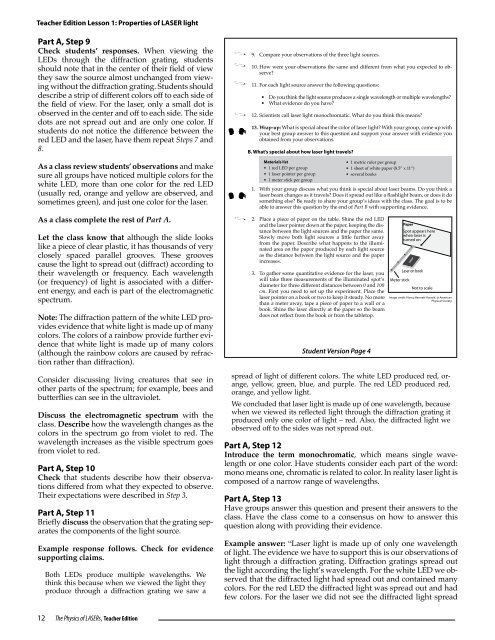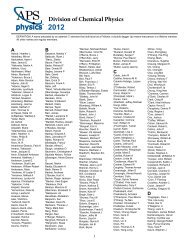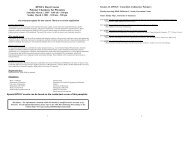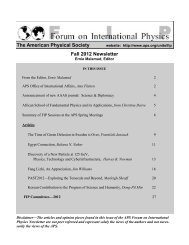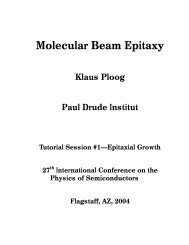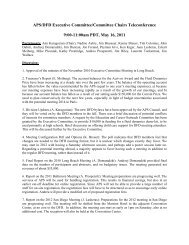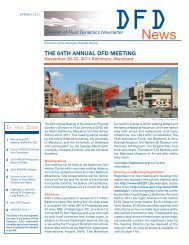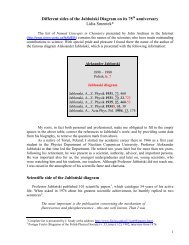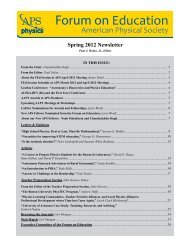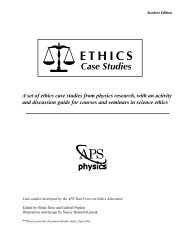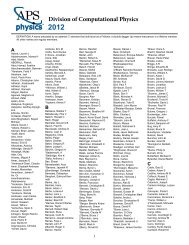The Physics of LASERs - American Physical Society
The Physics of LASERs - American Physical Society
The Physics of LASERs - American Physical Society
You also want an ePaper? Increase the reach of your titles
YUMPU automatically turns print PDFs into web optimized ePapers that Google loves.
Teacher Edition Lesson 1: Properties <strong>of</strong> LASER light<br />
Part A, Step 9<br />
Check students’ responses. When viewing the<br />
LEDs through the diffraction grating, students<br />
should note that in the center <strong>of</strong> their field <strong>of</strong> view<br />
they saw the source almost unchanged from viewing<br />
without the diffraction grating. Students should<br />
describe a strip <strong>of</strong> different colors <strong>of</strong>f to each side <strong>of</strong><br />
the field <strong>of</strong> view. For the laser, only a small dot is<br />
observed in the center and <strong>of</strong>f to each side. <strong>The</strong> side<br />
dots are not spread out and are only one color. If<br />
students do not notice the difference between the<br />
red LED and the laser, have them repeat Steps 7 and<br />
8.<br />
As a class review students’ observations and make<br />
sure all groups have noticed multiple colors for the<br />
white LED, more than one color for the red LED<br />
(usually red, orange and yellow are observed, and<br />
sometimes green), and just one color for the laser.<br />
As a class complete the rest <strong>of</strong> Part A.<br />
Let the class know that although the slide looks<br />
like a piece <strong>of</strong> clear plastic, it has thousands <strong>of</strong> very<br />
closely spaced parallel grooves. <strong>The</strong>se grooves<br />
cause the light to spread out (diffract) according to<br />
their wavelength or frequency. Each wavelength<br />
(or frequency) <strong>of</strong> light is associated with a different<br />
energy, and each is part <strong>of</strong> the electromagnetic<br />
spectrum.<br />
Note: <strong>The</strong> diffraction pattern <strong>of</strong> the white LED provides<br />
evidence that white light is made up <strong>of</strong> many<br />
colors. <strong>The</strong> colors <strong>of</strong> a rainbow provide further evidence<br />
that white light is made up <strong>of</strong> many colors<br />
(although the rainbow colors are caused by refraction<br />
rather than diffraction).<br />
Consider discussing living creatures that see in<br />
other parts <strong>of</strong> the spectrum; for example, bees and<br />
butterflies can see in the ultraviolet.<br />
Discuss the electromagnetic spectrum with the<br />
class. Describe how the wavelength changes as the<br />
colors in the spectrum go from violet to red. <strong>The</strong><br />
wavelength increases as the visible spectrum goes<br />
from violet to red.<br />
Part A, Step 10<br />
Check that students describe how their observations<br />
differed from what they expected to observe.<br />
<strong>The</strong>ir expectations were described in Step 3.<br />
Part A, Step 11<br />
Briefly discuss the observation that the grating separates<br />
the components <strong>of</strong> the light source.<br />
Example response follows. Check for evidence<br />
supporting claims.<br />
12<br />
Both LEDs produce multiple wavelengths. We<br />
think this because when we viewed the light they<br />
produce through a diffraction grating we saw a<br />
<strong>The</strong> <strong>Physics</strong> <strong>of</strong> <strong>LASERs</strong>, Teacher Edition<br />
Student Edition Lesson 1: Properties <strong>of</strong> LASER light<br />
4<br />
9. Compare your observations <strong>of</strong> the three light sources.<br />
10. How were your observations the same and different from what you expected to observe?<br />
11. For each light source answer the following questions:<br />
<strong>The</strong> <strong>Physics</strong> <strong>of</strong> <strong>LASERs</strong><br />
• Do you think the light source produces a single wavelength or multiple wavelengths?<br />
• What evidence do you have?<br />
12. Scientists call laser light monochromatic. What do you think this means?<br />
13. Wrap-up: What is special about the color <strong>of</strong> laser light? With your group, come up with<br />
your best group answer to this question and support your answer with evidence you<br />
obtained from your observations.<br />
B. What’s special about how laser light travels?<br />
Materials list<br />
• 1 red LED per group<br />
• 1 laser pointer per group<br />
• 1 meter stick per group<br />
1. With your group discuss what you think is special about laser beams. Do you think a<br />
laser beam changes as it travels? Does it spread out like a flashlight beam, or does it do<br />
something else? Be ready to share your group’s ideas with the class. <strong>The</strong> goal is to be<br />
able to answer this question by the end <strong>of</strong> Part B with supporting evidence.<br />
2. Place a piece <strong>of</strong> paper on the table. Shine the red LED<br />
and the laser pointer down at the paper, keeping the distance<br />
between the light sources and the paper the same.<br />
Slowly move both light sources a little further away<br />
from the paper. Describe what happens to the illuminated<br />
area on the paper produced by each light source<br />
as the distance between the light source and the paper<br />
increases.<br />
3. To gather some quantitative evidence for the laser, you<br />
will take three measurements <strong>of</strong> the illuminated spot’s<br />
diameter for three different distances between 0 and 100<br />
cm. First you need to set up the experiment. Place the<br />
laser pointer on a book or two to keep it steady. No more<br />
than a meter away, tape a piece <strong>of</strong> paper to a wall or a<br />
book. Shine the laser directly at the paper so the beam<br />
does not reflect from the book or from the tabletop.<br />
Student Version Page 4<br />
• 1 metric ruler per group<br />
• 1 sheet <strong>of</strong> white paper (8.5” x 11”)<br />
• several books<br />
Image credit: Nancy Bennett-Karasik, @ <strong>American</strong><br />
<strong>Physical</strong> <strong>Society</strong><br />
spread <strong>of</strong> light <strong>of</strong> different colors. <strong>The</strong> white LED produced red, orange,<br />
yellow, green, blue, and purple. <strong>The</strong> red LED produced red,<br />
orange, and yellow light.<br />
We concluded that laser light is made up <strong>of</strong> one wavelength, because<br />
when we viewed its reflected light through the diffraction grating it<br />
produced only one color <strong>of</strong> light – red. Also, the diffracted light we<br />
observed <strong>of</strong>f to the sides was not spread out.<br />
Part A, Step 12<br />
Introduce the term monochromatic, which means single wavelength<br />
or one color. Have students consider each part <strong>of</strong> the word:<br />
mono means one, chromatic is related to color. In reality laser light is<br />
composed <strong>of</strong> a narrow range <strong>of</strong> wavelengths.<br />
Part A, Step 13<br />
Have groups answer this question and present their answers to the<br />
class. Have the class come to a consensus on how to answer this<br />
question along with providing their evidence.<br />
Example answer: “Laser light is made up <strong>of</strong> only one wavelength<br />
<strong>of</strong> light. <strong>The</strong> evidence we have to support this is our observations <strong>of</strong><br />
light through a diffraction grating. Diffraction gratings spread out<br />
the light according the light’s wavelength. For the white LED we observed<br />
that the diffracted light had spread out and contained many<br />
colors. For the red LED the diffracted light was spread out and had<br />
few colors. For the laser we did not see the diffracted light spread


